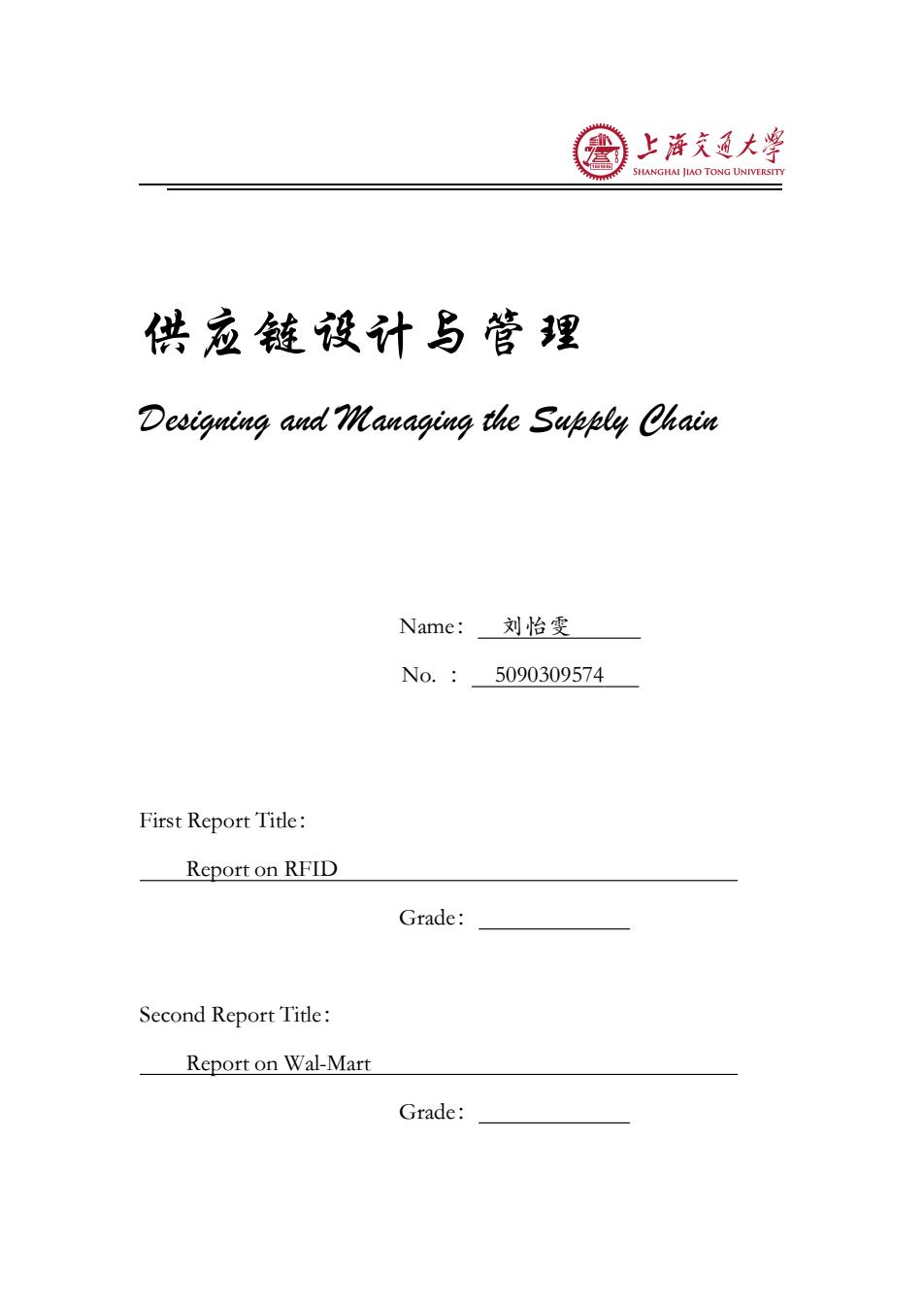
上游充通大 SHANGHAI JIAO TONG UNIVERSITY 供应链设计与管理 Designing and Wanaging the Supply Chain Name:刘怡雯 No.: 5090309574 First Report Title: Report on RFID Grade: Second Report Title: Report on Wal-Mart Grade:
供应链设计与管理 Designing and Managing the Supply Chain Name: 刘怡雯 No. : 5090309574 First Report Title: Report on RFID Grade: Second Report Title: Report on Wal-Mart Grade:

Report on RFID Background As an emerging technology around the world,RFID has become one the most important and promising factor in many industries.People are more and more interested in that and have spent much time on using and developing this high-tech.After watching online classes,I get known some uses of RFID.In this report,my topic will be the use of RFID in medical system. Introduction Radio-frequency identification(RFID)is the use of a wireless non-contact system that uses radio-frequency electromagnetic fields to transfer data from a tag attached to an object,for the purposes of automatic identification and tracking.Some tags require no battery and are powered by the electromagnetic fields used to read them.Others use a local power source and emit radio waves (electromagnetic radiation at radio frequencies).The tag contains electronically stored information which can be read from up to several meters(yards)away. Unlike a bar code,the tag does not need to be within line of sight of the reader and may be embedded in the tracked object. RFID tags are used in many industries.An RFID tag attached to an automobile during production can be used to track its progress through the assembly line.Pharmaceuticals can be tracked through warehouses.Livestock and pets may have tags injected,allowing positive identification of the animal. Since RFID tags can be attached to clothing,possessions,or even implanted within people,the possibility of reading personally-linked information without consent has raised privacy concerns. Main Use 1.Track and trace Track and trace the whole process before certified medical apparatus and medicine reach the hospital and after that how it is sold to patients.I want to get known how the technology works to ensure the quality and safety. Nowadays,there is an increasing phenomenon that some illegal private
Report on RFID Background As an emerging technology around the world, RFID has become one the most important and promising factor in many industries. People are more and more interested in that and have spent much time on using and developing this high-tech. After watching online classes, I get known some uses of RFID. In this report, my topic will be the use of RFID in medical system. Introduction Radio-frequency identification (RFID) is the use of a wireless non-contact system that uses radio-frequency electromagnetic fields to transfer data from a tag attached to an object, for the purposes of automatic identification and tracking. Some tags require no battery and are powered by the electromagnetic fields used to read them. Others use a local power source and emit radio waves (electromagnetic radiation at radio frequencies). The tag contains electronically stored information which can be read from up to several meters (yards) away. Unlike a bar code, the tag does not need to be within line of sight of the reader and may be embedded in the tracked object. RFID tags are used in many industries. An RFID tag attached to an automobile during production can be used to track its progress through the assembly line. Pharmaceuticals can be tracked through warehouses. Livestock and pets may have tags injected, allowing positive identification of the animal. Since RFID tags can be attached to clothing, possessions, or even implanted within people, the possibility of reading personally-linked information without consent has raised privacy concerns. Main Use 1. Track and trace Track and trace the whole process before certified medical apparatus and medicine reach the hospital and after that how it is sold to patients. I want to get known how the technology works to ensure the quality and safety. Nowadays, there is an increasing phenomenon that some illegal private
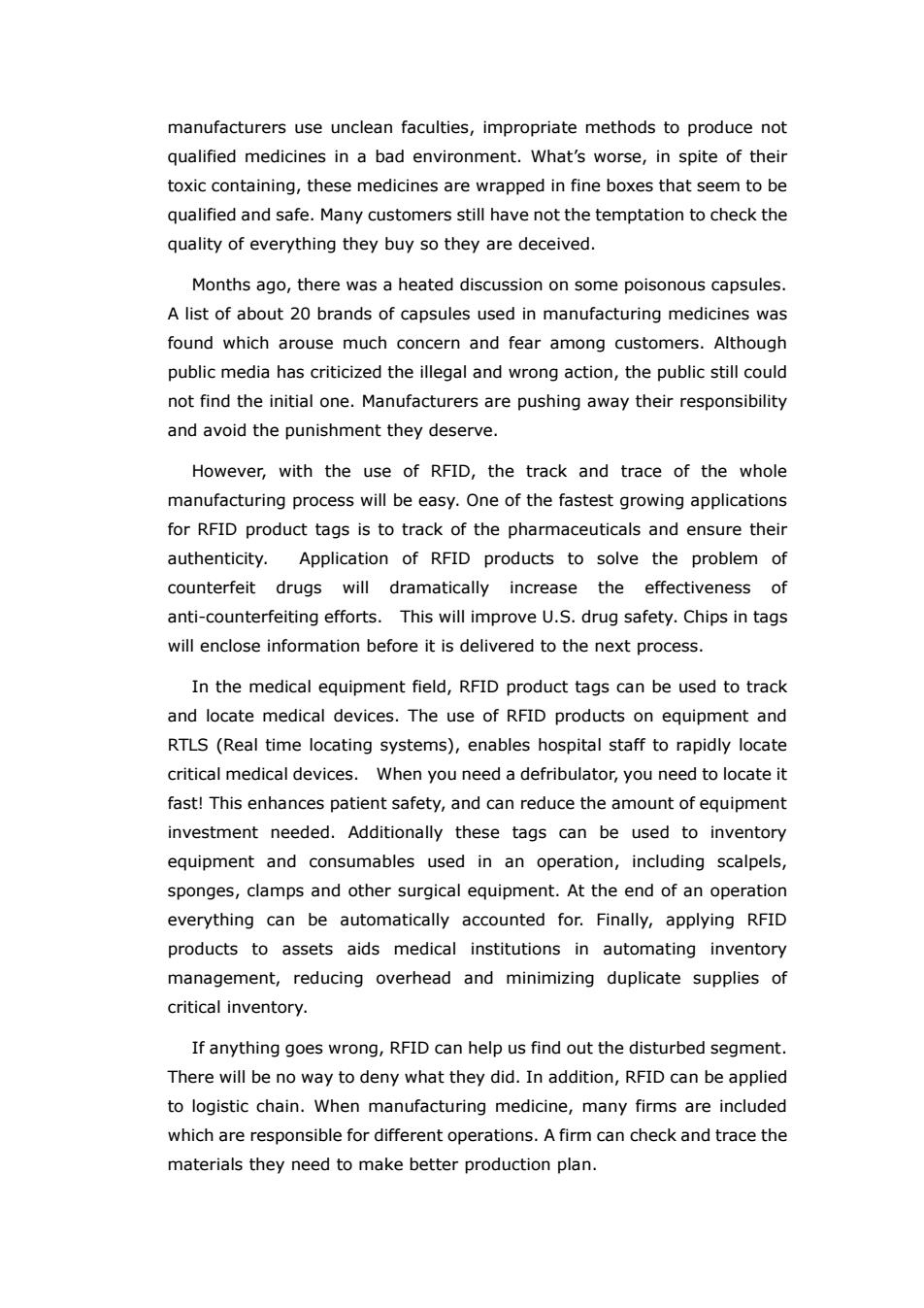
manufacturers use unclean faculties,impropriate methods to produce not qualified medicines in a bad environment.What's worse,in spite of their toxic containing,these medicines are wrapped in fine boxes that seem to be qualified and safe.Many customers still have not the temptation to check the quality of everything they buy so they are deceived. Months ago,there was a heated discussion on some poisonous capsules. A list of about 20 brands of capsules used in manufacturing medicines was found which arouse much concern and fear among customers.Although public media has criticized the illegal and wrong action,the public still could not find the initial one.Manufacturers are pushing away their responsibility and avoid the punishment they deserve. However,with the use of RFID,the track and trace of the whole manufacturing process will be easy.One of the fastest growing applications for RFID product tags is to track of the pharmaceuticals and ensure their authenticity.Application of RFID products to solve the problem of counterfeit drugs will dramatically increase the effectiveness of anti-counterfeiting efforts.This will improve U.S.drug safety.Chips in tags will enclose information before it is delivered to the next process. In the medical equipment field,RFID product tags can be used to track and locate medical devices.The use of RFID products on equipment and RTLS (Real time locating systems),enables hospital staff to rapidly locate critical medical devices.When you need a defribulator,you need to locate it fast!This enhances patient safety,and can reduce the amount of equipment investment needed.Additionally these tags can be used to inventory equipment and consumables used in an operation,including scalpels, sponges,clamps and other surgical equipment.At the end of an operation everything can be automatically accounted for.Finally,applying RFID products to assets aids medical institutions in automating inventory management,reducing overhead and minimizing duplicate supplies of critical inventory. If anything goes wrong,RFID can help us find out the disturbed segment. There will be no way to deny what they did.In addition,RFID can be applied to logistic chain.When manufacturing medicine,many firms are included which are responsible for different operations.A firm can check and trace the materials they need to make better production plan
manufacturers use unclean faculties, impropriate methods to produce not qualified medicines in a bad environment. What’s worse, in spite of their toxic containing, these medicines are wrapped in fine boxes that seem to be qualified and safe. Many customers still have not the temptation to check the quality of everything they buy so they are deceived. Months ago, there was a heated discussion on some poisonous capsules. A list of about 20 brands of capsules used in manufacturing medicines was found which arouse much concern and fear among customers. Although public media has criticized the illegal and wrong action, the public still could not find the initial one. Manufacturers are pushing away their responsibility and avoid the punishment they deserve. However, with the use of RFID, the track and trace of the whole manufacturing process will be easy. One of the fastest growing applications for RFID product tags is to track of the pharmaceuticals and ensure their authenticity. Application of RFID products to solve the problem of counterfeit drugs will dramatically increase the effectiveness of anti-counterfeiting efforts. This will improve U.S. drug safety. Chips in tags will enclose information before it is delivered to the next process. In the medical equipment field, RFID product tags can be used to track and locate medical devices. The use of RFID products on equipment and RTLS (Real time locating systems), enables hospital staff to rapidly locate critical medical devices. When you need a defribulator, you need to locate it fast! This enhances patient safety, and can reduce the amount of equipment investment needed. Additionally these tags can be used to inventory equipment and consumables used in an operation, including scalpels, sponges, clamps and other surgical equipment. At the end of an operation everything can be automatically accounted for. Finally, applying RFID products to assets aids medical institutions in automating inventory management, reducing overhead and minimizing duplicate supplies of critical inventory. If anything goes wrong, RFID can help us find out the disturbed segment. There will be no way to deny what they did. In addition, RFID can be applied to logistic chain. When manufacturing medicine, many firms are included which are responsible for different operations. A firm can check and trace the materials they need to make better production plan
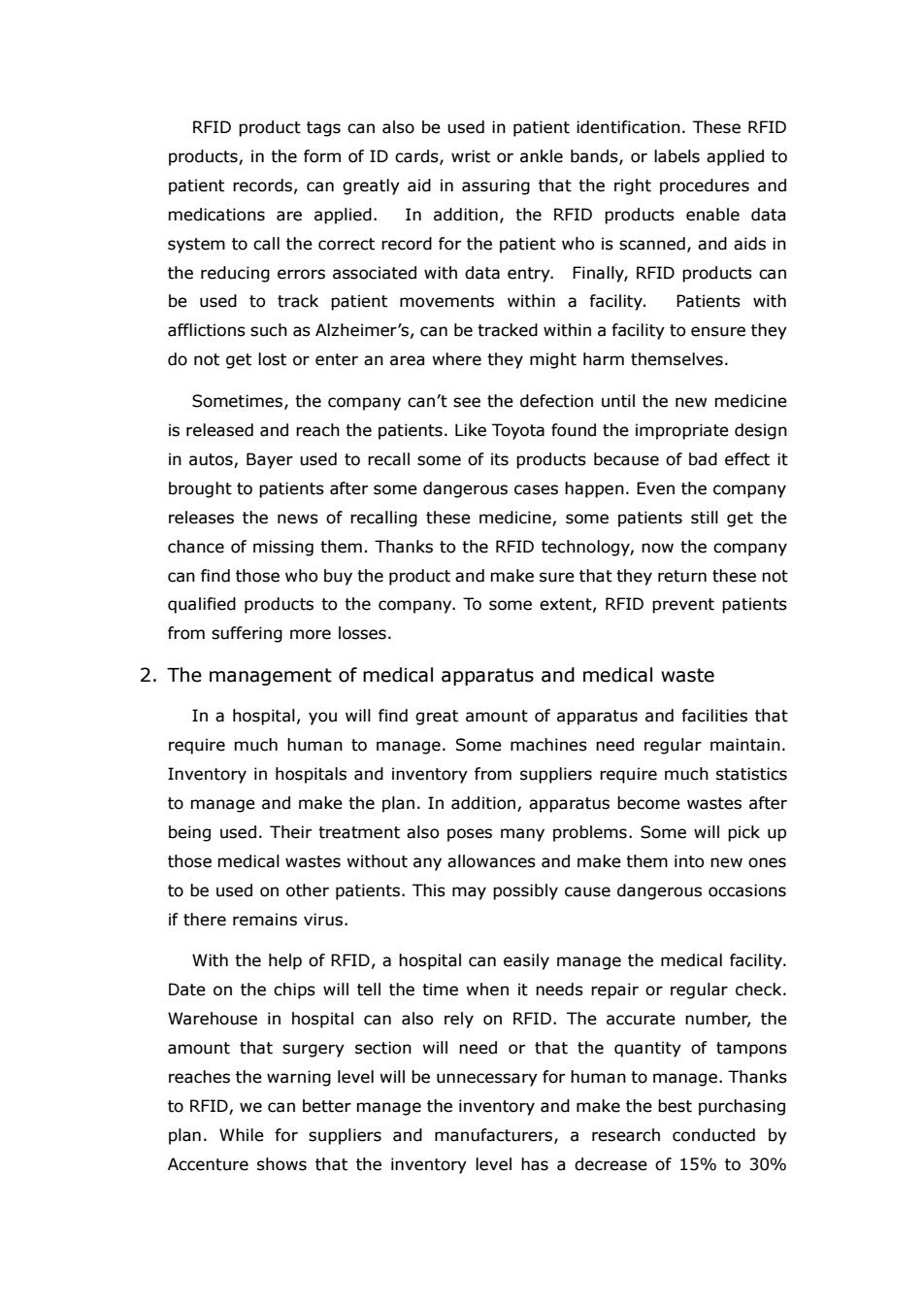
RFID product tags can also be used in patient identification.These RFID products,in the form of ID cards,wrist or ankle bands,or labels applied to patient records,can greatly aid in assuring that the right procedures and medications are applied.In addition,the RFID products enable data system to call the correct record for the patient who is scanned,and aids in the reducing errors associated with data entry.Finally,RFID products can be used to track patient movements within a facility.Patients with afflictions such as Alzheimer's,can be tracked within a facility to ensure they do not get lost or enter an area where they might harm themselves. Sometimes,the company can't see the defection until the new medicine is released and reach the patients.Like Toyota found the impropriate design in autos,Bayer used to recall some of its products because of bad effect it brought to patients after some dangerous cases happen.Even the company releases the news of recalling these medicine,some patients still get the chance of missing them.Thanks to the RFID technology,now the company can find those who buy the product and make sure that they return these not qualified products to the company.To some extent,RFID prevent patients from suffering more losses. 2.The management of medical apparatus and medical waste In a hospital,you will find great amount of apparatus and facilities that require much human to manage.Some machines need regular maintain. Inventory in hospitals and inventory from suppliers require much statistics to manage and make the plan.In addition,apparatus become wastes after being used.Their treatment also poses many problems.Some will pick up those medical wastes without any allowances and make them into new ones to be used on other patients.This may possibly cause dangerous occasions if there remains virus. With the help of RFID,a hospital can easily manage the medical facility. Date on the chips will tell the time when it needs repair or regular check. Warehouse in hospital can also rely on RFID.The accurate number,the amount that surgery section will need or that the quantity of tampons reaches the warning level will be unnecessary for human to manage.Thanks to RFID,we can better manage the inventory and make the best purchasing plan.While for suppliers and manufacturers,a research conducted by Accenture shows that the inventory level has a decrease of 15%to 30%
RFID product tags can also be used in patient identification. These RFID products, in the form of ID cards, wrist or ankle bands, or labels applied to patient records, can greatly aid in assuring that the right procedures and medications are applied. In addition, the RFID products enable data system to call the correct record for the patient who is scanned, and aids in the reducing errors associated with data entry. Finally, RFID products can be used to track patient movements within a facility. Patients with afflictions such as Alzheimer’s, can be tracked within a facility to ensure they do not get lost or enter an area where they might harm themselves. Sometimes, the company can’t see the defection until the new medicine is released and reach the patients. Like Toyota found the impropriate design in autos, Bayer used to recall some of its products because of bad effect it brought to patients after some dangerous cases happen. Even the company releases the news of recalling these medicine, some patients still get the chance of missing them. Thanks to the RFID technology, now the company can find those who buy the product and make sure that they return these not qualified products to the company. To some extent, RFID prevent patients from suffering more losses. 2. The management of medical apparatus and medical waste In a hospital, you will find great amount of apparatus and facilities that require much human to manage. Some machines need regular maintain. Inventory in hospitals and inventory from suppliers require much statistics to manage and make the plan. In addition, apparatus become wastes after being used. Their treatment also poses many problems. Some will pick up those medical wastes without any allowances and make them into new ones to be used on other patients. This may possibly cause dangerous occasions if there remains virus. With the help of RFID, a hospital can easily manage the medical facility. Date on the chips will tell the time when it needs repair or regular check. Warehouse in hospital can also rely on RFID. The accurate number, the amount that surgery section will need or that the quantity of tampons reaches the warning level will be unnecessary for human to manage. Thanks to RFID, we can better manage the inventory and make the best purchasing plan. While for suppliers and manufacturers, a research conducted by Accenture shows that the inventory level has a decrease of 15% to 30%
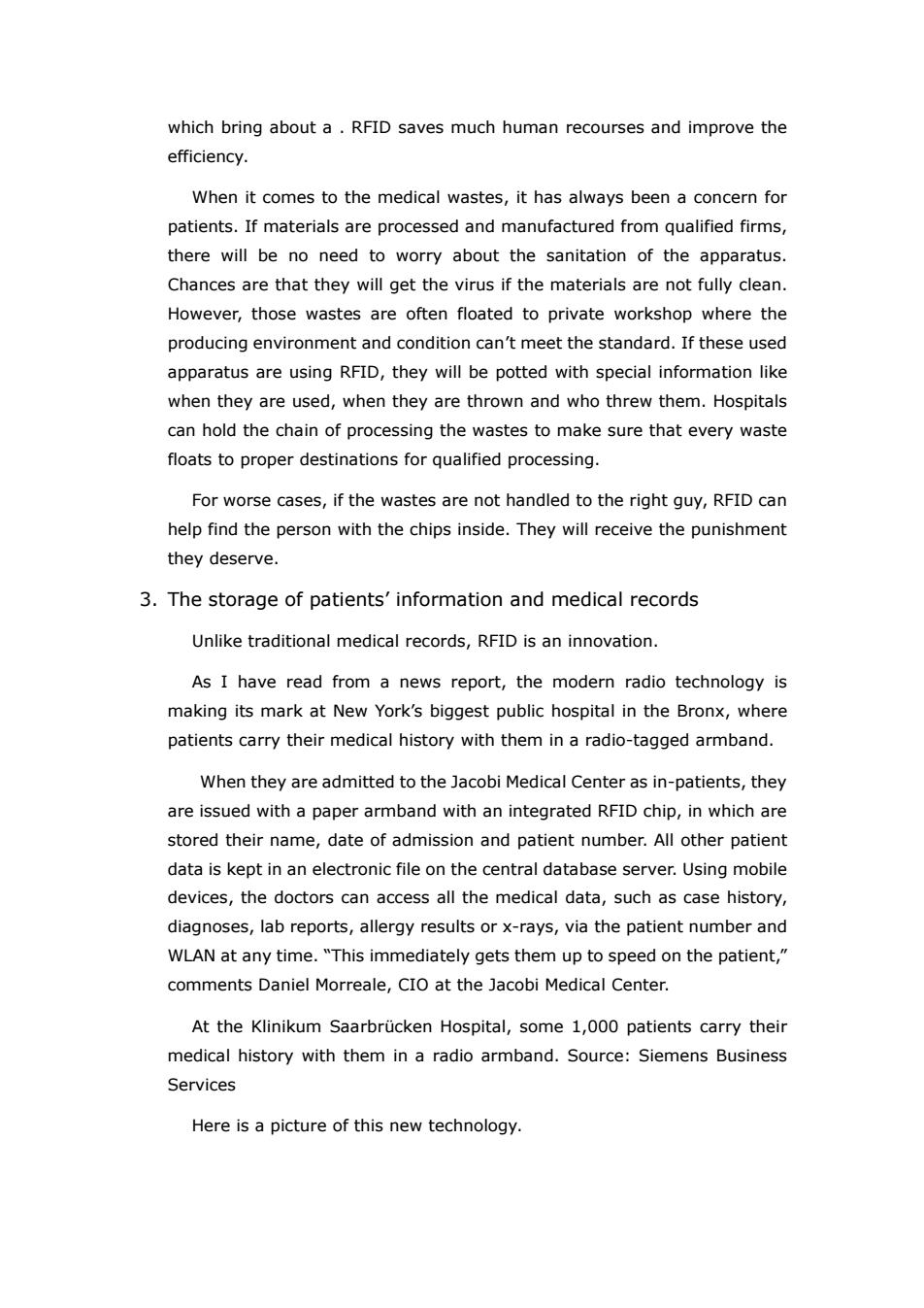
which bring about a.RFID saves much human recourses and improve the efficiency. When it comes to the medical wastes,it has always been a concern for patients.If materials are processed and manufactured from qualified firms, there will be no need to worry about the sanitation of the apparatus. Chances are that they will get the virus if the materials are not fully clean. However,those wastes are often floated to private workshop where the producing environment and condition can't meet the standard.If these used apparatus are using RFID,they will be potted with special information like when they are used,when they are thrown and who threw them.Hospitals can hold the chain of processing the wastes to make sure that every waste floats to proper destinations for qualified processing. For worse cases,if the wastes are not handled to the right guy,RFID can help find the person with the chips inside.They will receive the punishment they deserve. 3.The storage of patients'information and medical records Unlike traditional medical records,RFID is an innovation. As I have read from a news report,the modern radio technology is making its mark at New York's biggest public hospital in the Bronx,where patients carry their medical history with them in a radio-tagged armband. When they are admitted to the Jacobi Medical Center as in-patients,they are issued with a paper armband with an integrated RFID chip,in which are stored their name,date of admission and patient number.All other patient data is kept in an electronic file on the central database server.Using mobile devices,the doctors can access all the medical data,such as case history, diagnoses,lab reports,allergy results or x-rays,via the patient number and WLAN at any time."This immediately gets them up to speed on the patient," comments Daniel Morreale,CIO at the Jacobi Medical Center. At the Klinikum Saarbrucken Hospital,some 1,000 patients carry their medical history with them in a radio armband.Source:Siemens Business Services Here is a picture of this new technology
which bring about a . RFID saves much human recourses and improve the efficiency. When it comes to the medical wastes, it has always been a concern for patients. If materials are processed and manufactured from qualified firms, there will be no need to worry about the sanitation of the apparatus. Chances are that they will get the virus if the materials are not fully clean. However, those wastes are often floated to private workshop where the producing environment and condition can’t meet the standard. If these used apparatus are using RFID, they will be potted with special information like when they are used, when they are thrown and who threw them. Hospitals can hold the chain of processing the wastes to make sure that every waste floats to proper destinations for qualified processing. For worse cases, if the wastes are not handled to the right guy, RFID can help find the person with the chips inside. They will receive the punishment they deserve. 3. The storage of patients’ information and medical records Unlike traditional medical records, RFID is an innovation. As I have read from a news report, the modern radio technology is making its mark at New York’s biggest public hospital in the Bronx, where patients carry their medical history with them in a radio-tagged armband. When they are admitted to the Jacobi Medical Center as in-patients, they are issued with a paper armband with an integrated RFID chip, in which are stored their name, date of admission and patient number. All other patient data is kept in an electronic file on the central database server. Using mobile devices, the doctors can access all the medical data, such as case history, diagnoses, lab reports, allergy results or x-rays, via the patient number and WLAN at any time. “This immediately gets them up to speed on the patient,” comments Daniel Morreale, CIO at the Jacobi Medical Center. At the Klinikum Saarbrücken Hospital, some 1,000 patients carry their medical history with them in a radio armband. Source: Siemens Business Services Here is a picture of this new technology
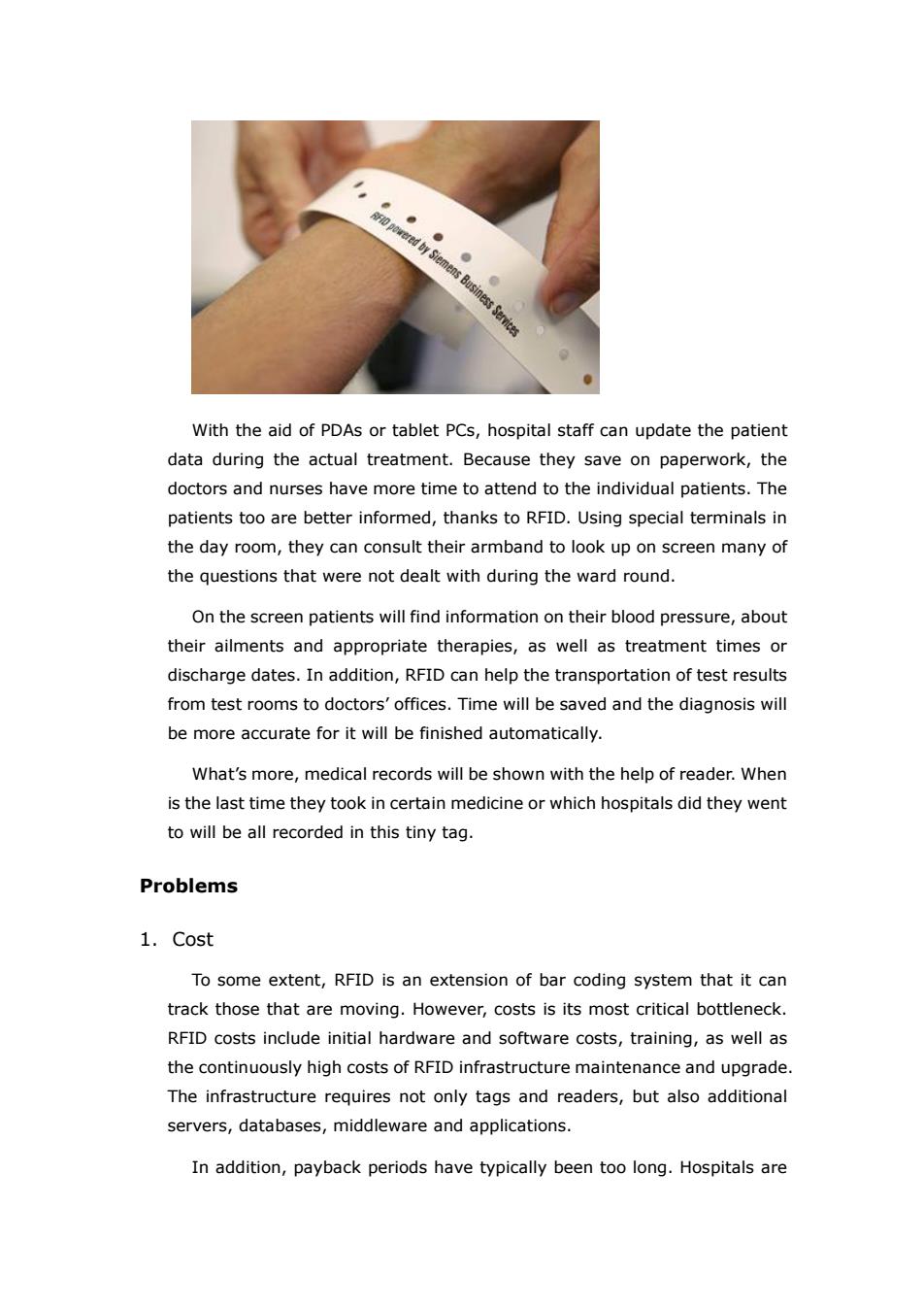
府0per时yS5 msins5 erices ● ● With the aid of PDAs or tablet PCs,hospital staff can update the patient data during the actual treatment.Because they save on paperwork,the doctors and nurses have more time to attend to the individual patients.The patients too are better informed,thanks to RFID.Using special terminals in the day room,they can consult their armband to look up on screen many of the questions that were not dealt with during the ward round. On the screen patients will find information on their blood pressure,about their ailments and appropriate therapies,as well as treatment times or discharge dates.In addition,RFID can help the transportation of test results from test rooms to doctors'offices.Time will be saved and the diagnosis will be more accurate for it will be finished automatically. What's more,medical records will be shown with the help of reader.When is the last time they took in certain medicine or which hospitals did they went to will be all recorded in this tiny tag. Problems 1.Cost To some extent,RFID is an extension of bar coding system that it can track those that are moving.However,costs is its most critical bottleneck. RFID costs include initial hardware and software costs,training,as well as the continuously high costs of RFID infrastructure maintenance and upgrade. The infrastructure requires not only tags and readers,but also additional servers,databases,middleware and applications. In addition,payback periods have typically been too long.Hospitals are
With the aid of PDAs or tablet PCs, hospital staff can update the patient data during the actual treatment. Because they save on paperwork, the doctors and nurses have more time to attend to the individual patients. The patients too are better informed, thanks to RFID. Using special terminals in the day room, they can consult their armband to look up on screen many of the questions that were not dealt with during the ward round. On the screen patients will find information on their blood pressure, about their ailments and appropriate therapies, as well as treatment times or discharge dates. In addition, RFID can help the transportation of test results from test rooms to doctors’ offices. Time will be saved and the diagnosis will be more accurate for it will be finished automatically. What’s more, medical records will be shown with the help of reader. When is the last time they took in certain medicine or which hospitals did they went to will be all recorded in this tiny tag. Problems 1. Cost To some extent, RFID is an extension of bar coding system that it can track those that are moving. However, costs is its most critical bottleneck. RFID costs include initial hardware and software costs, training, as well as the continuously high costs of RFID infrastructure maintenance and upgrade. The infrastructure requires not only tags and readers, but also additional servers, databases, middleware and applications. In addition, payback periods have typically been too long. Hospitals are
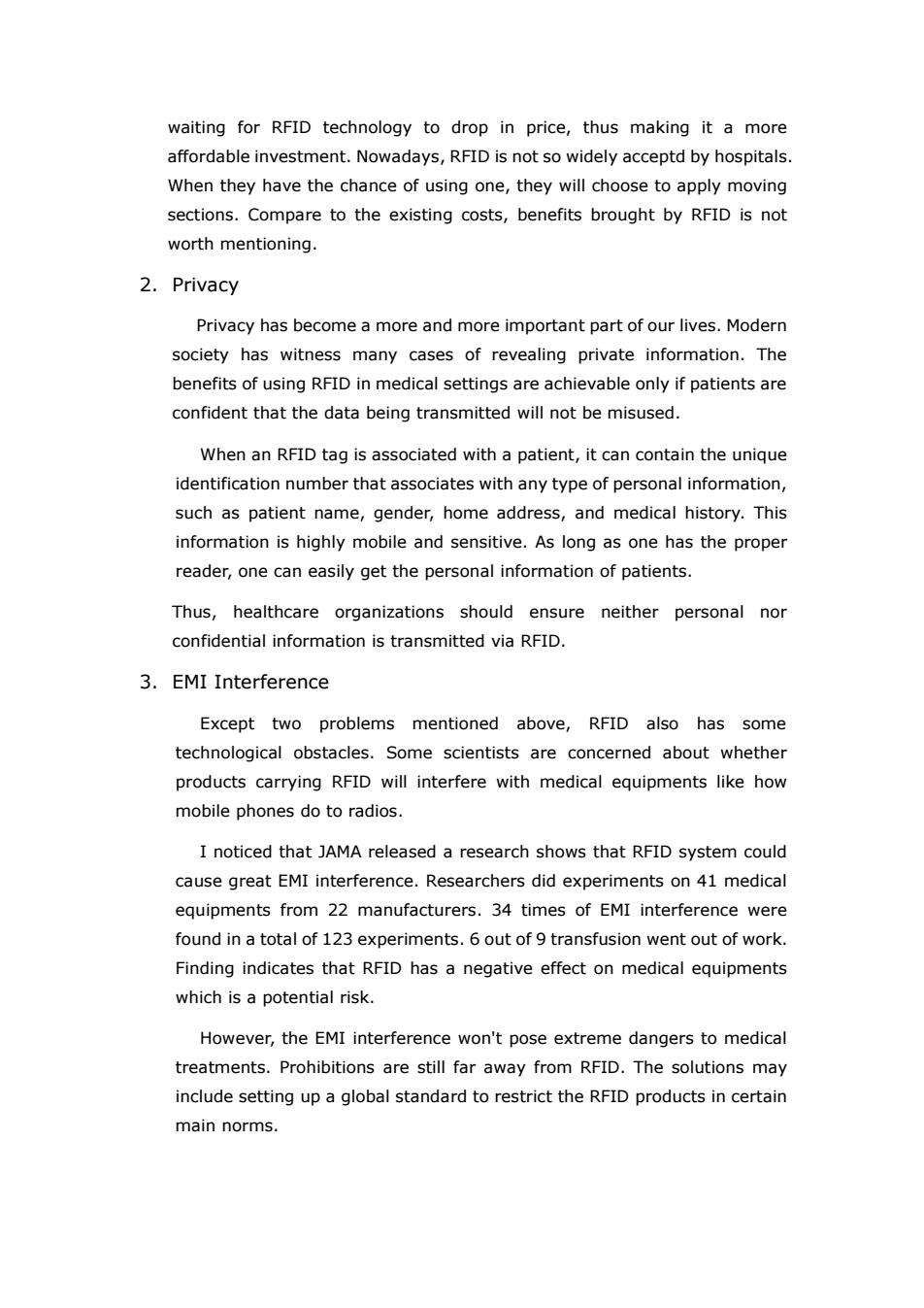
waiting for RFID technology to drop in price,thus making it a more affordable investment.Nowadays,RFID is not so widely acceptd by hospitals. When they have the chance of using one,they will choose to apply moving sections.Compare to the existing costs,benefits brought by RFID is not worth mentioning. 2.Privacy Privacy has become a more and more important part of our lives.Modern society has witness many cases of revealing private information.The benefits of using RFID in medical settings are achievable only if patients are confident that the data being transmitted will not be misused. When an RFID tag is associated with a patient,it can contain the unique identification number that associates with any type of personal information, such as patient name,gender,home address,and medical history.This information is highly mobile and sensitive.As long as one has the proper reader,one can easily get the personal information of patients. Thus,healthcare organizations should ensure neither personal nor confidential information is transmitted via RFID. 3.EMI Interference Except two problems mentioned above,RFID also has some technological obstacles.Some scientists are concerned about whether products carrying RFID will interfere with medical equipments like how mobile phones do to radios. I noticed that JAMA released a research shows that RFID system could cause great EMI interference.Researchers did experiments on 41 medical equipments from 22 manufacturers.34 times of EMI interference were found in a total of 123 experiments.6 out of 9 transfusion went out of work. Finding indicates that RFID has a negative effect on medical equipments which is a potential risk. However,the EMI interference won't pose extreme dangers to medical treatments.Prohibitions are still far away from RFID.The solutions may include setting up a global standard to restrict the RFID products in certain main norms
waiting for RFID technology to drop in price, thus making it a more affordable investment. Nowadays, RFID is not so widely acceptd by hospitals. When they have the chance of using one, they will choose to apply moving sections. Compare to the existing costs, benefits brought by RFID is not worth mentioning. 2. Privacy Privacy has become a more and more important part of our lives. Modern society has witness many cases of revealing private information. The benefits of using RFID in medical settings are achievable only if patients are confident that the data being transmitted will not be misused. When an RFID tag is associated with a patient, it can contain the unique identification number that associates with any type of personal information, such as patient name, gender, home address, and medical history. This information is highly mobile and sensitive. As long as one has the proper reader, one can easily get the personal information of patients. Thus, healthcare organizations should ensure neither personal nor confidential information is transmitted via RFID. 3. EMI Interference Except two problems mentioned above, RFID also has some technological obstacles. Some scientists are concerned about whether products carrying RFID will interfere with medical equipments like how mobile phones do to radios. I noticed that JAMA released a research shows that RFID system could cause great EMI interference. Researchers did experiments on 41 medical equipments from 22 manufacturers. 34 times of EMI interference were found in a total of 123 experiments. 6 out of 9 transfusion went out of work. Finding indicates that RFID has a negative effect on medical equipments which is a potential risk. However, the EMI interference won't pose extreme dangers to medical treatments. Prohibitions are still far away from RFID. The solutions may include setting up a global standard to restrict the RFID products in certain main norms
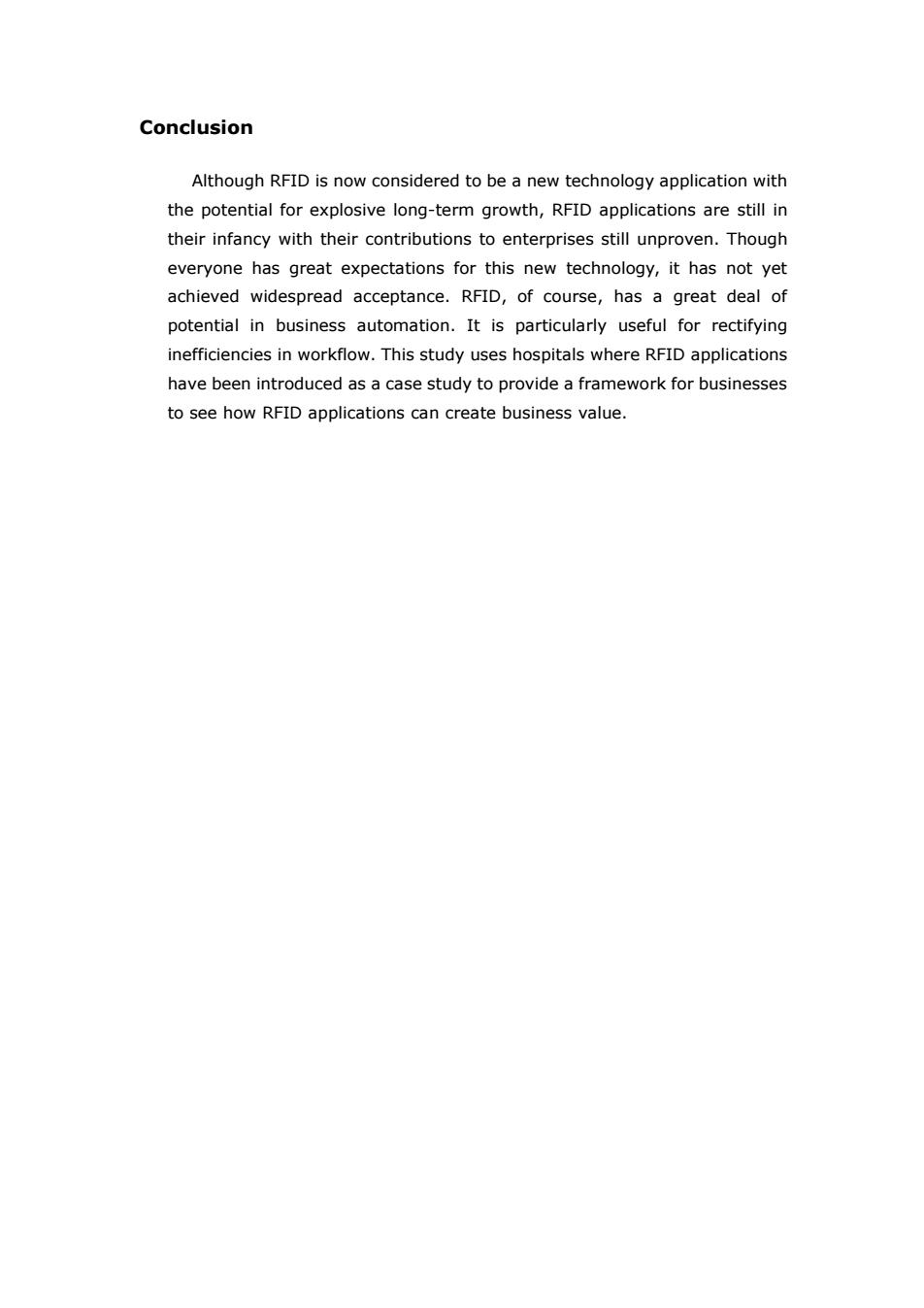
Conclusion Although RFID is now considered to be a new technology application with the potential for explosive long-term growth,RFID applications are still in their infancy with their contributions to enterprises still unproven.Though everyone has great expectations for this new technology,it has not yet achieved widespread acceptance.RFID,of course,has a great deal of potential in business automation.It is particularly useful for rectifying inefficiencies in workflow.This study uses hospitals where RFID applications have been introduced as a case study to provide a framework for businesses to see how RFID applications can create business value
Conclusion Although RFID is now considered to be a new technology application with the potential for explosive long-term growth, RFID applications are still in their infancy with their contributions to enterprises still unproven. Though everyone has great expectations for this new technology, it has not yet achieved widespread acceptance. RFID, of course, has a great deal of potential in business automation. It is particularly useful for rectifying inefficiencies in workflow. This study uses hospitals where RFID applications have been introduced as a case study to provide a framework for businesses to see how RFID applications can create business value